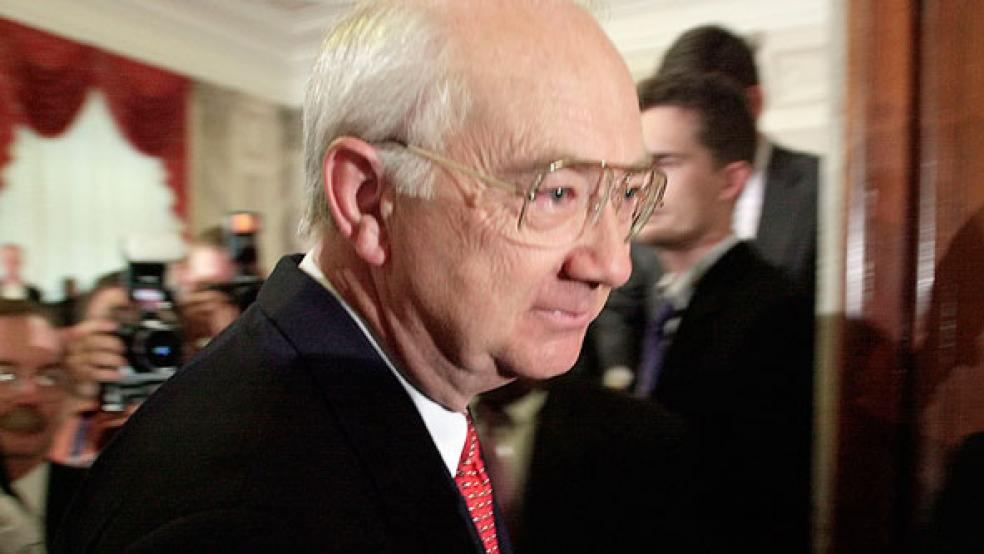Former Sen. Phil Gramm, R-Tex., the godfather of budget enforcement schemes, returned to the Capitol on Wednesday to offer advice to lawmakers attempting to craft a device to mandate deficit discipline if Congress fails to do so.
President Obama and a raft of fiscal experts and lawmakers are touting new ideas for budget caps and automatic spending-cut triggers as Democrats and Republicans attempt to negotiate a long-term plan for cutting the deficit and raising the federal debt ceiling. Gramm, now vice chairman of UBS Investment Bank, helped author the groundbreaking, albeit controversial, Gramm-Rudman-Hollings balanced budget act of 1985, designed to force Congress’s hand to cut the deficit to targeted levels.
“The deficit debate of today is eerily similar to the debate that occurred in 1985, when Gramm-Rudman became law,” Gramm told members of the Senate Finance Committee. “Yet the conditions demanding action today are far more compelling and far more dangerous.”
The Balanced Budget and Emergency Deficit Control Act – adopted as part of a deal back during the Reagan administration to raise the debt ceiling, was a “qualified success,” Gramm said today. He and other defenders say it was instrumental in slowing the rate of growth of spending and forced Congress to pay for a new Medicare entitlement program. Critics dismissed the law as a sham that was eventually scrapped after the targets it set for spending cuts proved so deep and onerous that they mostly never took effect.
There are two new budget enforcement proposals gaining considerable attention on Capitol Hill. One, introduced by Sen. Bob Corker, R-Tenn., and Claire McCaskill, D-Mo. And heavily pushed by the GOP, would eventually cap federal spending at 20.6 percent of the Gross Domestic Product, the average from 1970 through 2008. The other deficit reduction plan, promoted by former Democratic White House Budget chief Alice Rivlin and former Republican Senate Budget Committee chairman Pete V. Domenici, R-N.M., aims at reducing the debt-to-GDP ratio to 60 percent by 2018. Finance Committee Chairman Max Baucus, D-Mont., said that “A debt reduction trigger could be an important part of passing legislation to reduce our debt and move our economy in a positive direction toward growth and job creation.”
During his morning testimony, Gramm said that regardless of what Congress has in mind, these tips should be kept in mind:
- Make the automatic enforcement measure so tough that Congress will do everything it can to act on its own to avoid across-the-board cuts, known as sequestration. “It was never the objective of Gramm-Rudman to trigger the sequester; the objective of Gramm-Rudman was to have the threat of the sequester force compromise and action,” he said.
- Be careful not to include too many exceptions or “emergency exemptions” to the automatic spending cuts. Gramm-Rudman-Hollings was laced with a number of loopholes that put a large chunk of the budget off limits to cuts. “In the extreme case, funding for the Decennial Census was designated as an ‘emergency’ despite the fact that the Constitution had required that a census be taken every decade for 200 years,” he said.
- Any law should include the ability to look back and make additional spending cuts if necessary to correct any deficit overages.
- Finally, the only forcing mechanism that Congress should use is automatic spending cuts – not increases in taxes. A trigger that would increase tax revenues or reduce or eliminate popular tax breaks, would be “a non-starter with the public,” he said.
That last suggestion was music to the ears of Republican members who contend that the government’s historic $1.5 trillion deficit was born of runaway spending, not the inadequacy of federal tax revenues, and that any budget enforcement mechanism should focus on spending savings. Sen. Jon Kyl of Arizona, the Senate Republican Whip and a key player in talks on long term deficit reduction and the debt ceiling, told The Fiscal Times today: “We are not going to entertain any kind of revenue enhancements. We do believe there needs to be constraints on spending and those would be conditions for the extension of the debt ceiling.”
Sen. Benjamin C. Cardin, D-Md., disagreed, saying that tax expenditures or tax breaks that largely favor upper income Americans should be subject to cuts along with government spending to make the threat of the across the board spending cuts more convincing. “Including tax expenditures makes it more likely than less likely” that Congress will take the necessary action to avoid triggering the across the board cuts, Cardin said.
Paul N. Van De Water, a senior fellow at the liberal Center on Budget and Policy Priorities, cautioned that the Corker-McCaskill bill that is so popular with Republicans would focus primarily on spending cuts to close the gap between projected spending and the tough spending caps being proposed.
“The cuts needed to reach the cap through this mechanism would total about $1.3 trillion in Social Security, $860 billion in Medicare, and $550 billion in Medicaid just over the first nine years that the cap was in effect,” he said. “Placing such a cap on total spending would essentially absolve revenues – including tax expenditures – from playing any part in the effort to bring long-term deficits under control.”
Susan J. Irving, director for federal budget analysis at the U.S. Government Accountability Office, agreed with De Water that a budget enforcement mechanism geared more to trying to gradually stabilize the long-term debt to GDP ratio (along the lines of the Rivlin-Domenici plan) is a more appropriate and doable goal than targeting the long term spending to GDP ratio, as Corker and McCaskill advocate.
“You need a downward path of debt to GDP not for each year but every five years, and set a path of deficit reduction and then monitor that path,” she said.



